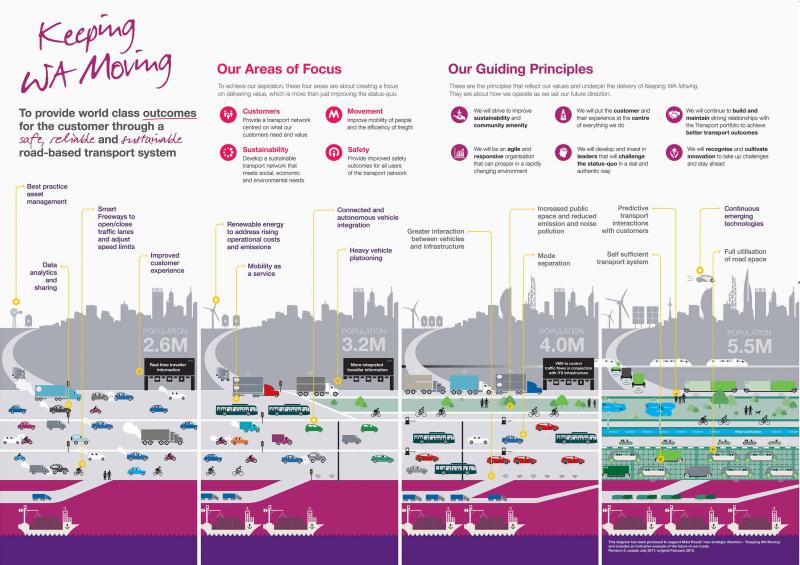Linking Strategy, Futures, Innovation and Research
Keeping WA Moving is our strategic direction; it underpins everything that we do. It defines our aspiration:
To provide world class outcomes for the customer through a safe, reliable and sustainable road-based transport system
It also clearly outlines our areas of focus as Customers, Movement, Sustainability and Safety. These areas underpin what we do and help us concentrate on delivering what is important.
During the year, we have been part of a society significantly affected by the COVID-19 global pandemic. At its height, almost 90 per cent of the world’s population were subject to international travel restrictions. This has been a stark reminder about the things that are important – our health and the connections we hold dear such as those with family and friends. The pandemic has caused many of us to change the way we think about how companies and individuals connect.
All of us know of family or friends impacted as businesses closed doors or were forced to operate in a different way, and many of us moved to working from home arrangements. These sudden changes drastically reduced use of the transport network, with interstate and overseas flights cancelled and a dramatic fall in the use of public transport and the road network.
The role of the transport network and the vulnerability of our supply chains in providing access to freight was also highlighted. Across the world, logistics and freight providers were granted exemptions to state border closures allowing supply of essential goods for communities and businesses. Increased online shopping and a massive reduction in air freight availability also had significant impacts.
In transport innovation, we saw the temporary shutdown of many automated driving (self-driving) system research efforts. Companies had committed to create robo-taxis – a fleet of automated vehicles people can share, moving transport to be a service and reducing the need to own a vehicle in metropolitan areas. It quickly became apparent the robo-taxi model was another opportunity for the spread of COVID-19.
The year was a stark reminder of the unpredictability of the future and of the role crisis can play in innovation and change. It also presents new questions:
- Will further waves of COVID-19 occur and influence transport use again?
- Are employees and employers more comfortable now with working from home arrangements and will these impact long-term trends?
- When will public confidence fully return in public transport post pandemic?
- Does the pandemic call into question the viability of the business model for ‘robo-taxi’ services to be deployed at full scale?
Moving into a new year we, like much of society, are left with new questions. These include seeking to understand whether the current situation causes longer term impacts on transport, and how to provide and deliver services.
We continue to monitor innovation around the world and prepare for potential futures. These may include, but are not limited to:
- Zero-emission vehicles: The switch to electric and hybrid vehicles from traditional petrol and diesel vehicles is underway.
- Connected and Automated Vehicles: Vehicles that can ‘talk’ to each other, to roadside infrastructure or even drive themselves are in development.
- Electric vertical takeoff and landing (eVTOL) passenger drones: These combine drone technology with electric vehicle battery technology to produce, in essence, a Jetsons-style ‘flying car’; a trial was recently announced for NSW.
- Drone deliveries: Many traditional logistics and e-commerce companies are exploring dropping packages by using drones, including an Australian trial to deliver coffee and burritos.
- 3D printing: 3D printers are, in parts of the world, being trialled for printing entire pedestrian bridges; but people are also envisaging a world where your internet order will be locally printed and delivered within hours. Perhaps by drone!
With so many potential futures for transport, we will use our understanding to inform strategy, innovation and research activities. We will also look to understand not only what the future might hold but also monitor whether our current situation fundamentally changes that vision.
To remind ourselves that the future will look different from today we visually represent our Keeping WA Moving strategic direction.
The point here is not accurate predictions of the future. Rather, thinking long term helps us lift ourselves away from immediate challenges and re-focus on what is important. Our future story is one vision of the future to start a conversation. Recent experience has shown this conversation may now have a very different narrative and outcome.
Taking this approach allows us to better prepare for the future. For example, a variety of technology, rideshare and traditional auto-manufacturing companies have committed to deliver driverless cars. From recent announcements, it appears this technology is delayed. However, we still need to understand how it could impact the transport network and still need to prepare for possible introduction.
With preparedness in mind, we contribute to federal and State Government initiatives by being a member or working on:

